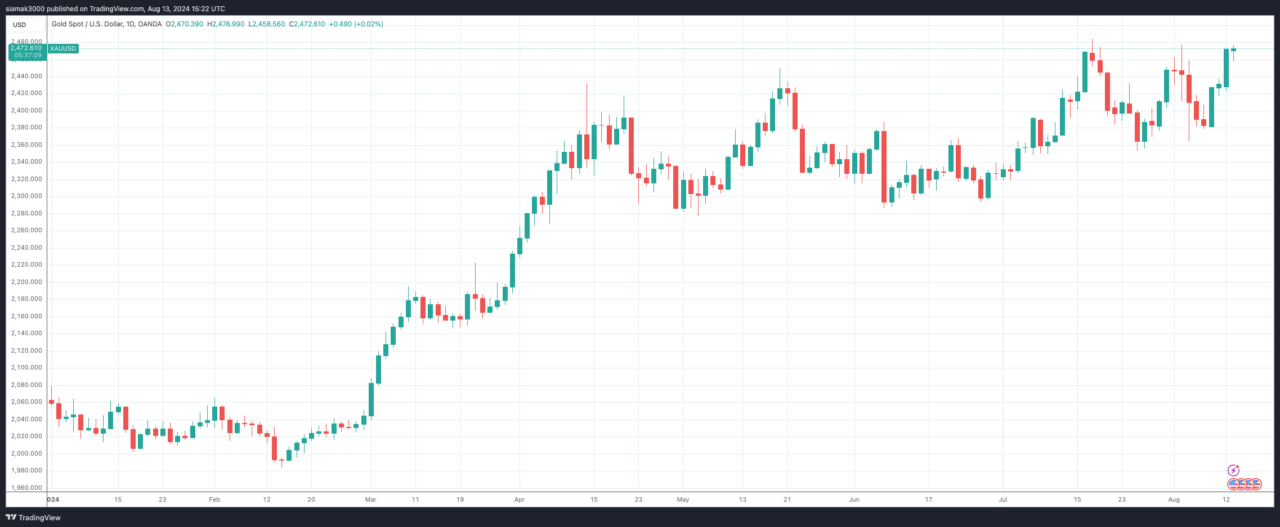In recent months, the price of gold has seen a significant uptick, approaching $2,500 per ounce. This surge in gold’s value has caught the attention of investors and analysts alike, particularly as traditional equity markets show signs of volatility and uncertainty. On August 12, Mike McGlone, Senior Macro Strategist at Bloomberg Intelligence, shared his insights on the gold market and broader commodity trends during an interview with Yahoo Finance.

Gold’s Ascent: A Signal of Larger Economic Issues
According to McGlone, the rise in gold prices is not just a fleeting trend but a signal of deeper macroeconomic challenges. He highlights that gold has been outperforming major stock indices, including the S&P 500, on a year-to-date, one-year, two-year, and three-year basis. This performance, McGlone argues, is indicative of significant underlying problems in the global economy.
McGlone is bullish on gold’s future, predicting that it will eventually reach $3,000 per ounce. He notes that gold has established strong support around the $2,000 mark, and this base may now be moving closer to $2,200. The strategist attributes gold’s strength to several key factors, including geopolitical shifts and the actions of central banks.
Geopolitical Shifts and Central Bank Actions
One of the pivotal events McGlone points to is the “unlimited friendship” between President Xi of China and President Putin of Russia, which he claims began in 2022, followed by Russia’s invasion of Ukraine. These developments, he suggests, have tilted the global order in favor of gold. McGlobe points out that central banks, which have some of the deepest pockets globally, have been significant buyers of gold during this period. Although there have been outflows from gold ETFs, recent months have seen a reversal, with inflows picking up again.
McGlone sees this as a recognition of gold’s role as a safe-haven asset, particularly in light of the risks associated with a potential U.S. recession and the peaking of U.S. bond yields from historically high levels.
The Role of Volatility and Stock Market Dynamics
Another critical factor in gold’s rise, according to McGlone, is the increasing volatility in the stock market. He has been vocal for nearly two years, questioning the rationale behind buying gold when U.S. Treasury T-bills offered a 5% return and the stock market was performing strongly. However, he now says this scenario seems to be changing, with volatility now emerging as a key indicator.
McGlone points to the VIX volatility index, which he notes is bottoming out from its lowest level since 2018. According to the Bloomberg strategist, this increase in volatility suggests that stock market prices may be reverting downward, even as the much-anticipated recession remains elusive. In contrast, he notes, gold has been a consistent outperformer, reinforcing its status as a critical asset in times of economic uncertainty.
Commodity Market Trends: A Broader Perspective
While gold has been the standout performer, McGlone provides a broader view of the commodity market. He notes that the Bloomberg Commodity Index has been down on a one-year basis, reflecting a global deflationary trend. Industrial metals, which were up by about 24% earlier in the year, have since declined. This, McGlone believes, signals the potential for further deflationary pressures.
Turning to oil, McGlone describes the current market as being in a bear phase. He attributes the decline in oil prices to the “high price cure” phenomenon, where elevated prices lead to reduced demand and eventually lower prices. McGlone predicts that oil could drop near or below its cost of production in the U.S., which he estimates at around $55 per barrel. He acknowledges that geopolitical issues and OPEC’s supply management have provided some support for prices, but he ultimately sees a downward trajectory as more likely.
Featured Image via Pixabay









